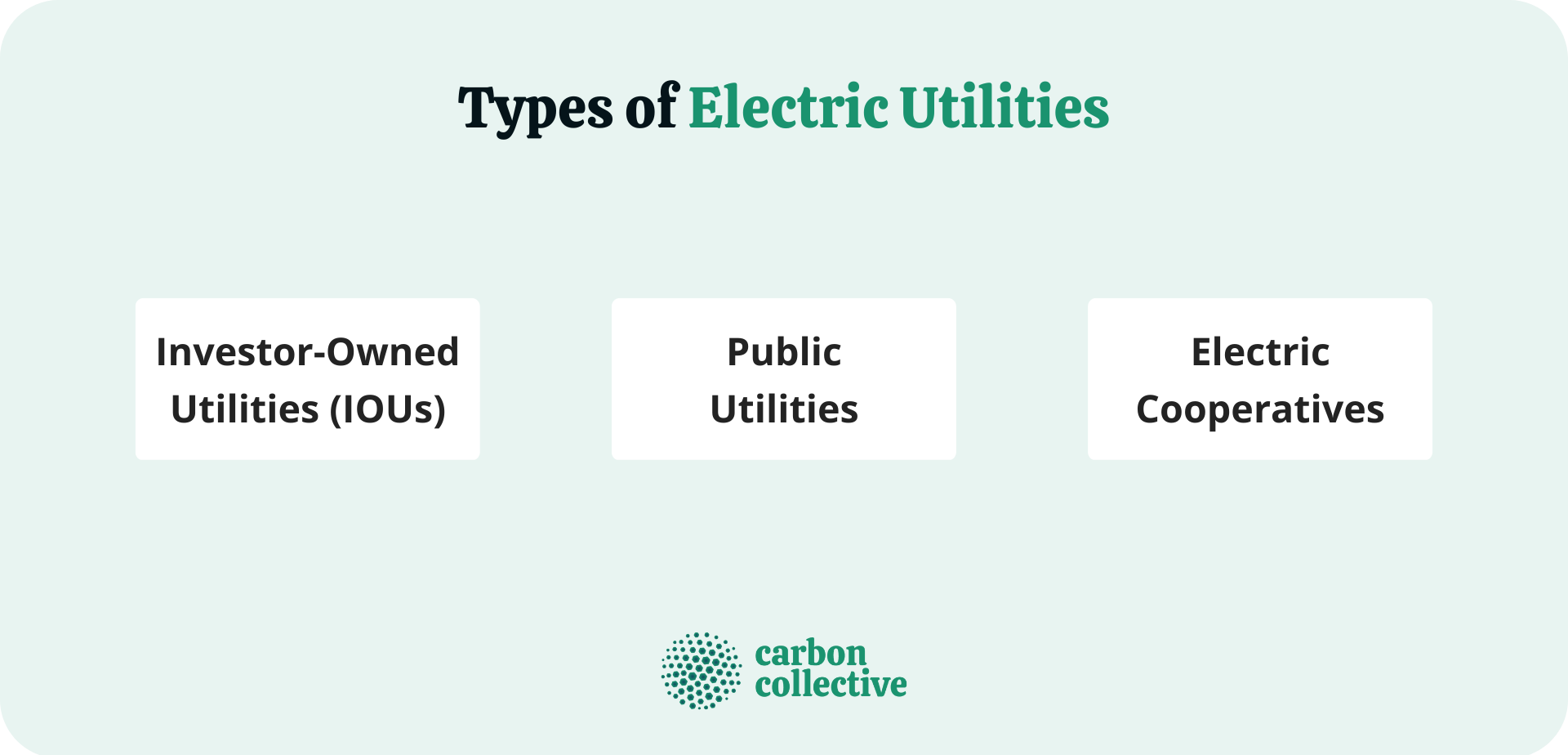Electric Utility
October 28, 2022
Author:
Zach Stein

Electric Utility Defined
An electric utility organization produces and delivers electric energy to the public.
Utilities are usually found as Investor-Owned Utilities (IOUs), although other types of utilities exist.
Types of Electric Utilities
There are three types of electric utilities: IOUs, public utilities, and electric cooperatives.

Investor-Owned Utilities (IOUs)
Investor-owned utilities are privately owned by stockholders.
IOUs fall under the category of for-profit organizations because of their private ownership, with profits passed down to owners and shareholders.
IOUs acquire power through long-term purchase agreements with power plants. They are considered the largest type of electric utility.
Public Utilities
This type of utility is owned by the state, province, or municipality and uses taxpayer dollars to run its business. These types of utilities are usually referred to as government-owned utilities (GOUs).
Locally elected officials manage these organizations.
Electric Cooperatives
These types of utilities are member-owned and controlled by their customers. They are private, non-profit organizations.
A board of directors elected by customers governs these co-ops.
Advantages of Electric Utilities
Electric utilities provide a reliable source of energy to homes and businesses.
They are usually found in remote areas where it is not economically feasible for private companies to run lines.
Utilities create competition which helps with the overall costs since different companies vie for your business. This also helps improve technology and find new sources of fuel or energy.
Disadvantages of Electric Utilities
Expensive utility infrastructure represents one of the disadvantages of electric utilities.
Due to costs, an electric utility must have a constant customer base. Decreased demand forces the utility to raise rates. This can lead to high bills for customers who cannot find cheaper alternatives.
Continual upgrades and maintenance also drive up utility expenses.
In their current state, electric utilities harm the environment. Below discusses the environmental effects of electric utilities.
Environmental Effects of Electric Utilities
Emission of Greenhouse Gases
The most common by-product of electric utilities is carbon dioxide, a greenhouse gas (GHG).
This GHG is particularly destructive because when mixed with other types of gas in the atmosphere, it traps radiation emitted from the earth, keeping that energy from escaping into space.
This causes global warming and changes in climate patterns, such as more frequent and intense rainfall, storms, and hurricanes.
Pollution
Another negative environmental effect of electric utilities is the release of nitrogen oxides, sulfur dioxide, and mercury.
These chemicals have links to numerous health issues, such as respiratory illness, heart disease, cancer, and birth defects.
Adverse Effects on Plants, Animals, and the Ecosystem
When coal-fired power plants are built near a river or stream, they contaminate the water with toxic pollutants, such as arsenic and lead.
Nuclear power plants also pose serious risks to rivers and streams because they require large quantities of water for cooling purposes.
Furthermore, burning fossil fuels, such as coal, release air pollutants that settle in the ground and migrate into the water table.
Reducing the Negative Environmental Effects
Energy Efficiency
One of the ways to reduce negative environmental effects is through energy efficiency.
The most common way to do this involves using more efficient lighting or insulating buildings, meaning they require less heat (in colder climates) or cooling (in warmer climates).
Energy efficiency can also be achieved by using renewable energy, such as wind and solar power.
Cogeneration
Cogeneration, otherwise known as combined heat and power (CHP), generates electricity and captures the excess heat for water or space heating.
Cogeneration reduces the number of pollutants released into the atmosphere through power plants by decreasing the amount of electricity required for generation.
The Bottom Line
In summary, utility organizations distribute electricity and other services to consumers.
They can be divided into three types: IOUs, public utilities, and electric cooperatives.
Electric utilities play a vital role in modern society, and they must remain as sustainable as possible.
Several negative environmental effects are associated with electric utilities, such as GHG emissions, pollution from toxic chemicals used in power plants, and the release of pollutants into the atmosphere.
However, these harmful effects can decrease by implementing energy efficiency and cogeneration techniques into a utility system.
With more careful planning and stakeholder input on how to use our planet's natural resources, we can use the system efficiently and sustainably to benefit everyone, especially future generations.
FAQs
1. What is the main difference between IOUs, public utilities, and electric cooperatives?
IOUs are investor-owned utilities, public utilities are government-run, and electric cooperatives are run by consumers.
2. Why is cogeneration considered helpful in reducing harmful environmental effects?
Cogeneration helps reduce greenhouse gas emissions because the process recaptures energy that would otherwise be wasted through heating or cooling. This reduces energy demand.
3. How can energy efficiency reduce negative environmental effects?
Energy efficiency helps reduce negative environmental effects because it cuts the amount of energy necessary to run a facility.
For instance, if a company can reduce its energy usage by 20%, the electricity demand will decrease, and fewer fossil fuels will need to be burned.
4. What are examples of environmental effects?
Some examples of environmental effects include acid rain, ozone depletion, and global warming.
Acid rain can contaminate waterways, while ozone depletion reduces air quality. Global warming contributes to climate changes that affect water levels and plant, animal, and human health.
5. What are other examples of utilities aside from electric utilities?
Gas, water, sewage, and sanitation are also utilities.
Our difference
01.
We're clear eyed.
We think financial security and climate health are directly linked.
02.
We're independent.
We're not owned by a big bank or Wall Street firm.
03.
We're real people.
You'll feel it the moment you meet us.

